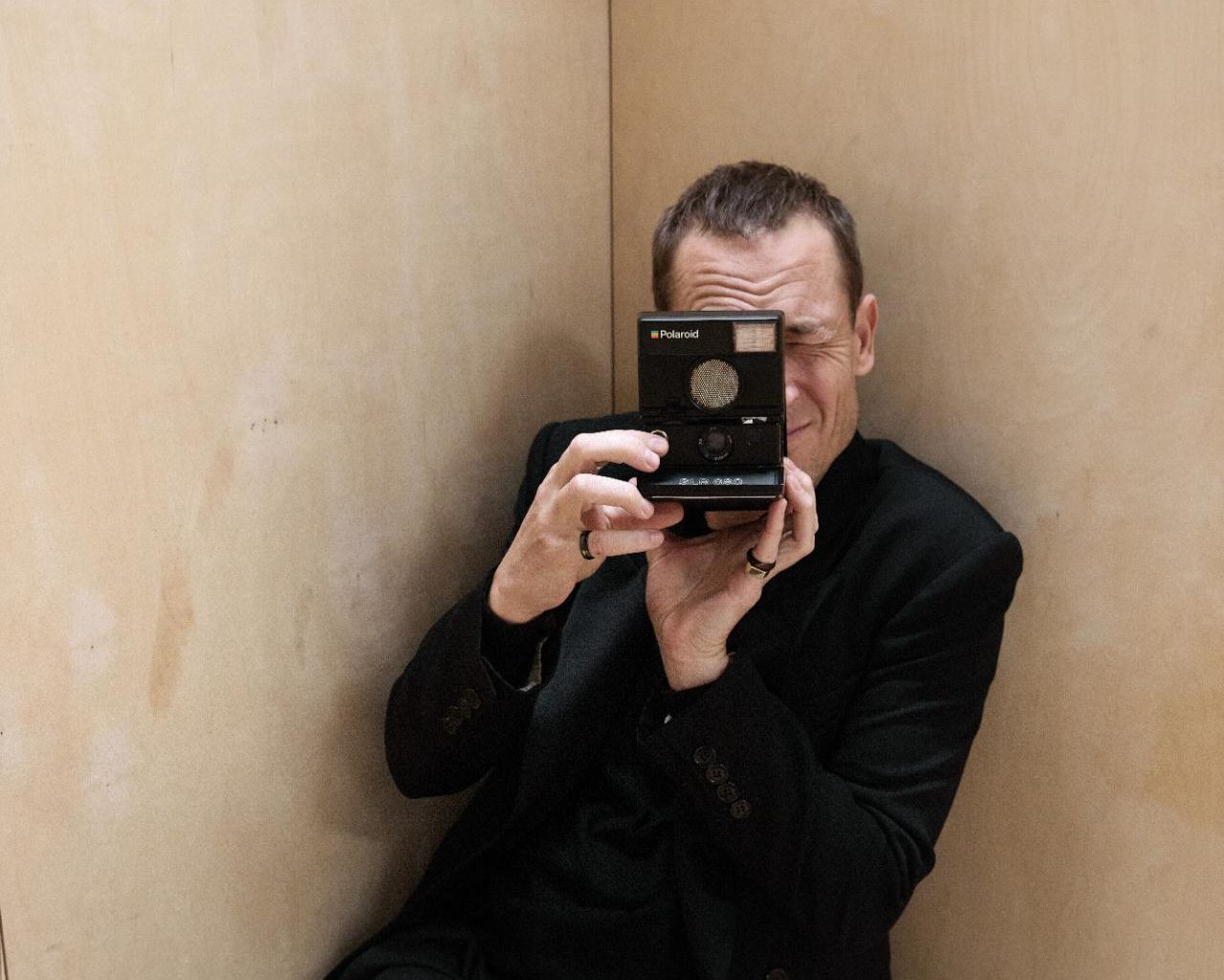
Rewrite
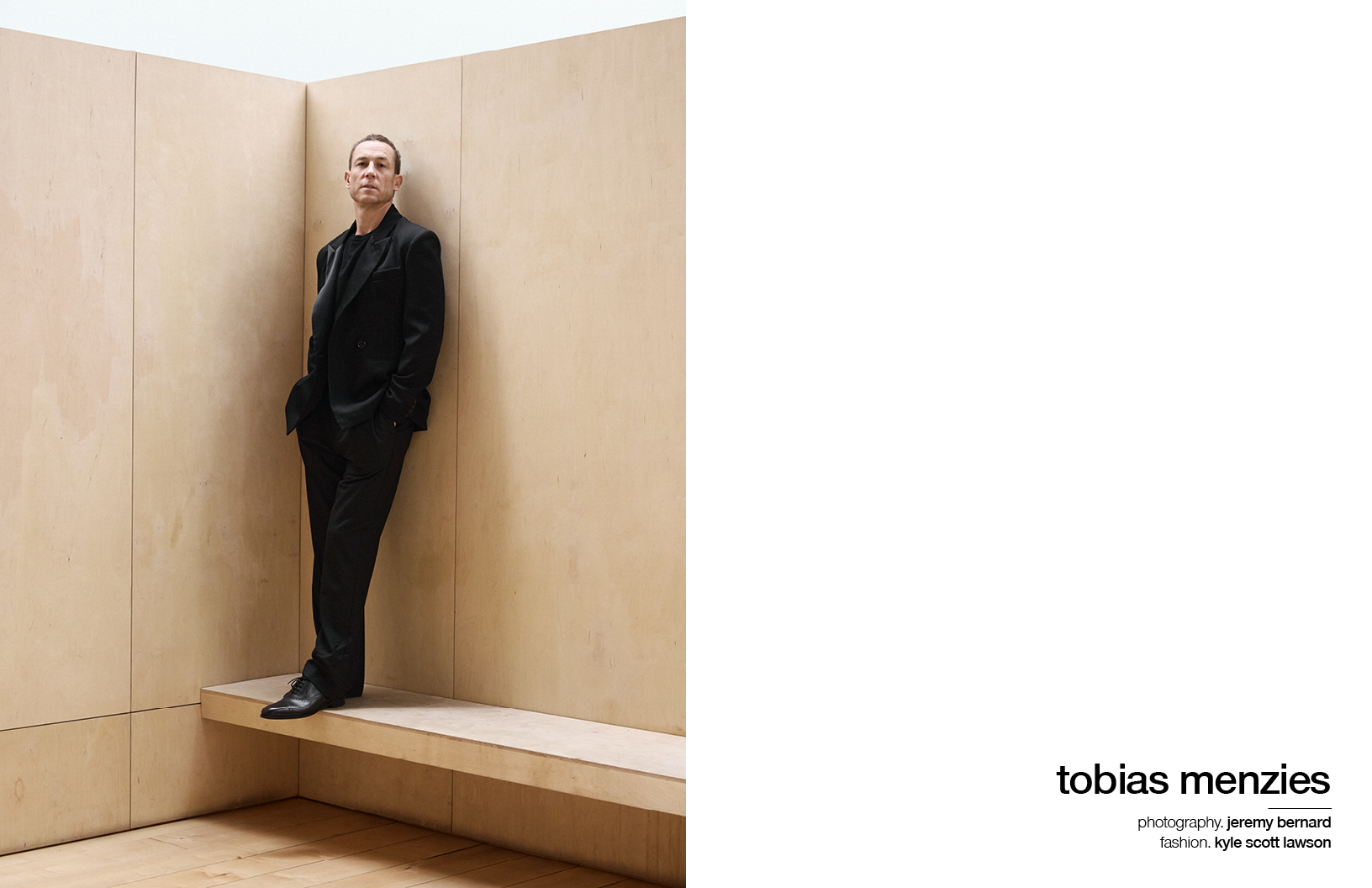
jacket. David Koma
sweater. Connolly
trousers. Reiss
shoes. Manolo Blahnik
Tobias Menzies has had a career for the ages. Ranging from royalty to rogue and all things in between for the screen and stage, he morphs with ease from one role to another with practiced confidence. When we sit down to chat during a particularly scorching summer day, the conversation envelopes everything from the very beginning of his career, from ‘Outlander’ to ‘The Crown’, to where he is today in Apple TV’s ‘F1: The Movie’.
Working with some of the greats, Brad Pitt, Javier Bardem, and Damson Idris, Menzies finds himself in incredible company, taking everything within its stride. The first film of its kind, to be filmed alongside Formula One racers, and on a live racetrack, Menzies couldn’t pass up the opportunity to be part of something so big. Something so innovative to life.
Bringing the role of Peter Banning to life, the man with the rules and the red tape, the actor is no stranger to playing the villain or antagonist. And as our chat continues, he explains how a villain never truly sees themselves in the wrong, or as the foil. They simply believe in their convictions, which makes it all the more enthralling to portray. A villain is not a villain in their own mind, but the hero of their own story, and he relishes the chance to be able to give these characters the dimension that they deserve.
In conversation with Schön!, Menzies discusses ‘F1: The Movie’, the innovation behind the camera, what he looks for in a role, how he approaches the stage versus the screen, and much more.
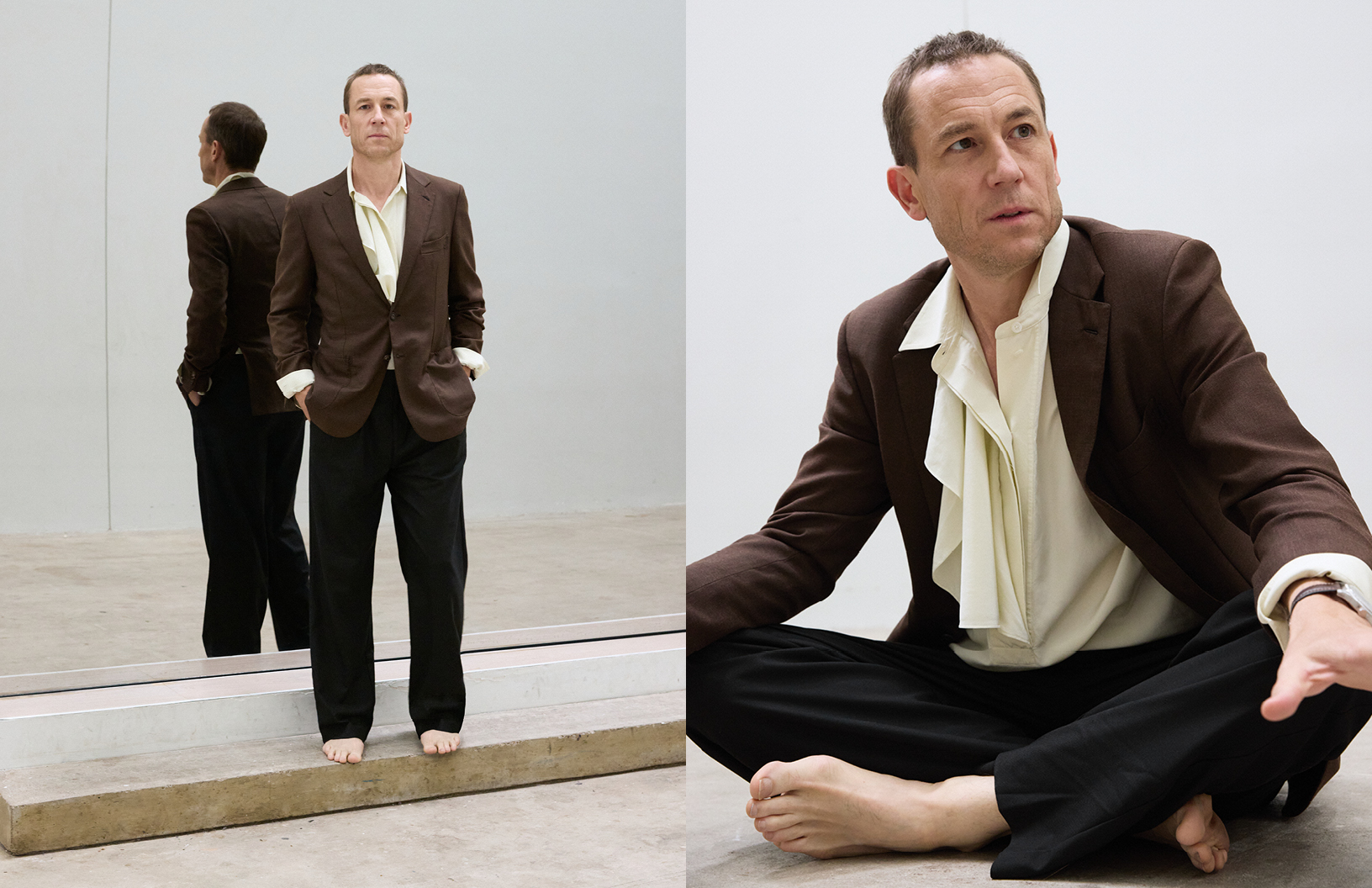
jacket. Brioni
shirt. Connolly
trousers. Reiss
opposite
jacket. Brioni
shirt. Connolly
trousers. Reiss
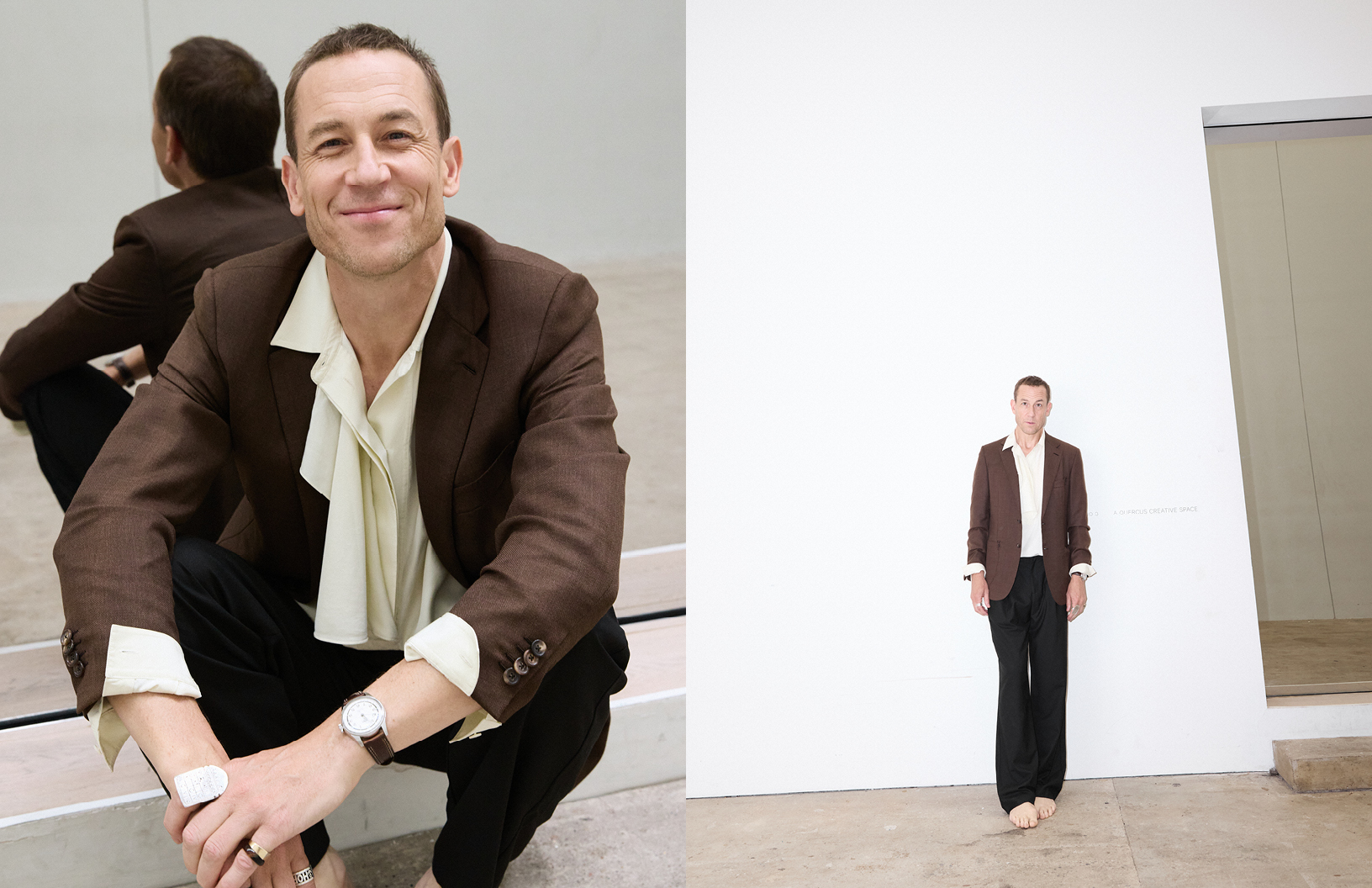
jacket. Brioni
shirt. Connolly
trousers. Reiss
opposite
jacket. Brioni
shirt. Connolly
trousers. Reiss
You’ve been cast in period pieces, ‘Game of Thrones’, ‘Outlander’, ‘Persuasion’, ‘The Crown’, and ‘Rome’. What is it about period pieces that you love so much? Is there a particular part of history you’d like to tackle in the future?
I don’t know. I’m not quite sure what that’s about. But I guess I’m partly drawn to more classic stories that tend to have great story bones. I’m naturally drawn to that than some of the more modern material.
Beyond period pieces, is there a genre you’d like to wade into?
Nothing springs to mind. Have you got any in mind?
Maybe science fiction? I know you were in an episode of ‘Doctor Who’, so it would be cool to see you do more of that.
I’m open to that.
Moving to ‘F1’, what was it about Banning that piqued your interest when you read the script?
It was the overall package I was interested in. The world seemed inherently cinematic. I think what Joe (Korsinski) was looking to do was take an audience inside those cars, give them a real sense of the speed and the jeopardy that felt exciting. I got to work with Javier Bardem and Brad Pitt in this film. It was an amazing opportunity to see how they work up close. It felt like there was enough in the part to land something. The money is such a huge part of this sport. It’s incredibly expensive to do and to be involved in.
Banning represents some of the machinations that go on behind the scenes of what you see at the races and on TV. There’s a lot of business going on. He’s representing some of that cutthroat end of it.
He’s the red tape and the money exchanging hands that we don’t get to see, essentially.
Yes. I would say he’s an interesting part of it. I think everyone involved, Brad (Pitt) and Joe particularly, were keen to make it as authentic as possible. To make it a very accurate representation of the world overall. So, both the pit lane, but also the paddock club, and the money flows, and to see all the different strata of how this stuff works.
With all that being said, what makes Peter Banning a good villain or foil in your eyes?
I’ll be totally honest, I did not play him like a villain. I didn’t think of him as a villain, really. No one thinks of himself as a villain. I don’t think Peter Banning thinks of himself as a villain. He’s a businessman. He thinks of what would be best for the team. In a different film, he would be the hero.
Do you think there should be a part two to tell Banning’s POV?
Yeah, why not? Let’s do the spinoff [laughs].
The film is so incredibly big budget. The trailer teases extreme speed that audiences are going to be thrilled with. Were there any moments that kind of took your breath away and almost broke you out of character?
No, not while shooting. But I mean, I was on set and watching the bank of monitors at times when Damson Idris was doing what they call hot laps, where F1 gave the production use of the track in between practice sessions. The production is allowed to take out their cars and drive the real track. They would drive more than 180 miles an hour, 150 miles an hour rather, I think.
One of the things I love about the film is the camera work, specifically the technology used to place those cameras inside the car while the actors are actually driving. It gives an amazing sense of the pace they’re going at, the genuine danger of that. I don’t really feel like that’s being rendered on film as successfully as this film does. I think you get a sense of that. It was exciting to watch that happening live. The stuff we shot on Silverstone grid was a very unusual and unique sort of shooting situation. One that I’m unlikely to repeat.
Did you get the chance to go behind the wheel at any point?
No, I mean, I imagine the insurance is incredibly complex just to get Damson and Brad behind a F2 car disguised as an F1 car and to drive that fast. I don’t know how the insurance worked on that. It wasn’t an open-door policy on the car front.
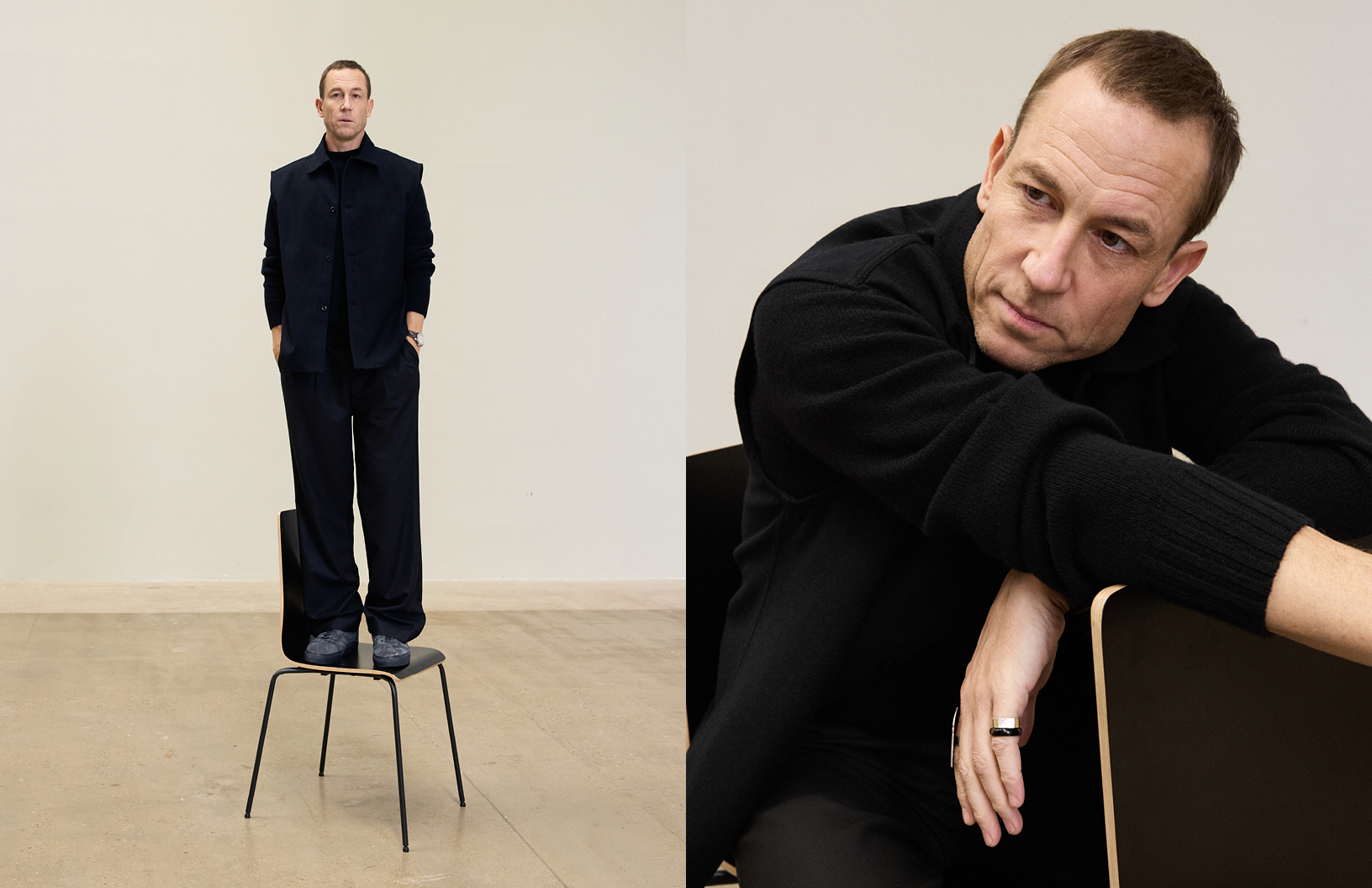
jacket + sweater. Margaret Howell
trousers. REISS
shoes. Grenson
watch + jewellery. Talent’s Own
opposite
jacket + sweater. Margaret Howell
trousers. REISS
watch + jewellery. Talent’s Own
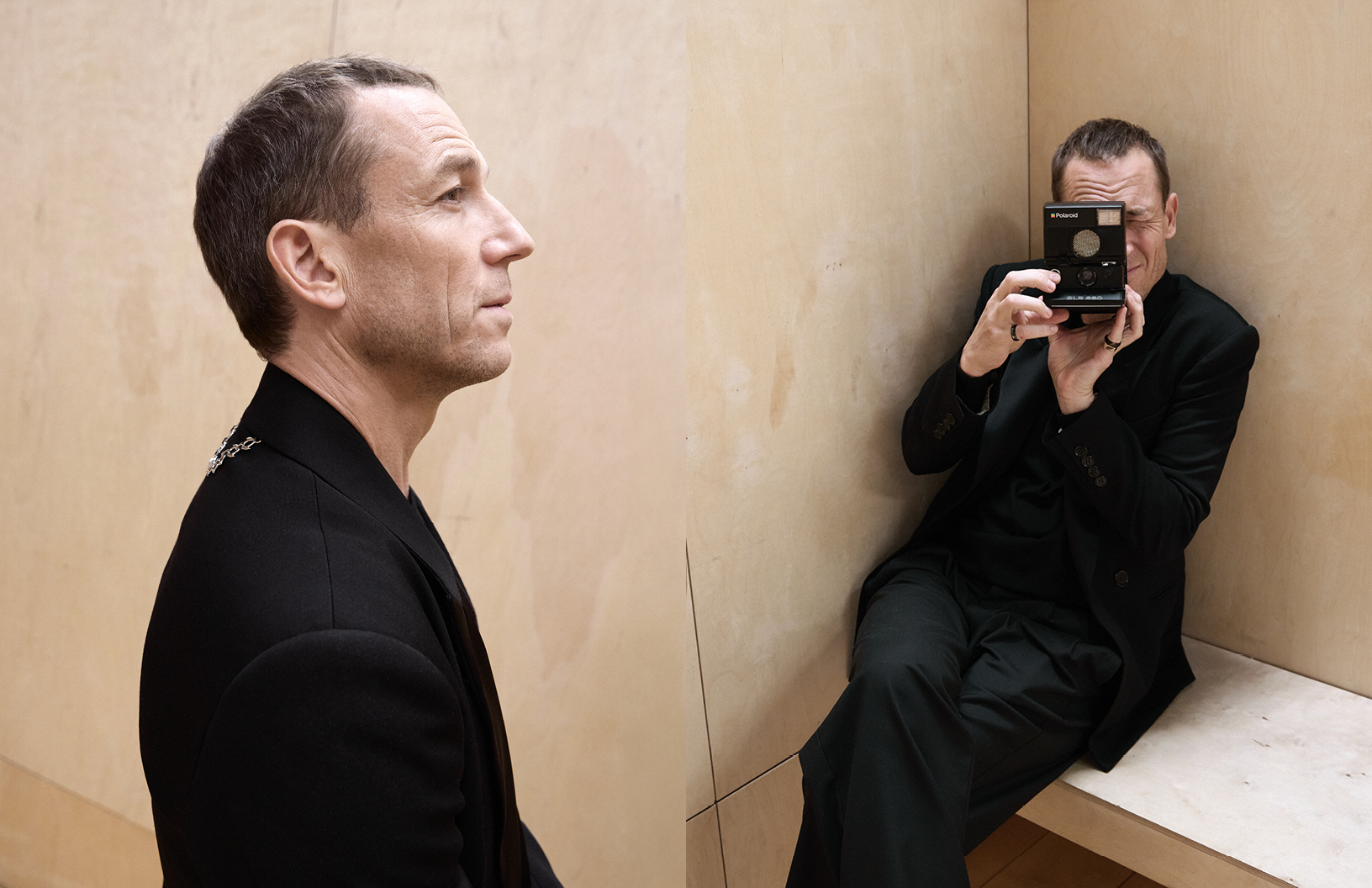
jacket. David Koma
opposite
jacket. David Koma
sweater. Connolly
trousers. Reiss
Moving away from the film for just a moment, I wanted to touch on the theatre. Can you talk a little bit about the challenges of acting between stage and screen? What creative muscles does one flex over the other?
I think it’s all the same stuff, really. It is the same activity. It’s the same muscles. It’s just, I guess, the question of the lens size, how far you’re having to sort of push it out. But I mean, my taste in theatre is less is more anyway. I think you try to make an audience come to you within reason. Similarly, with a camera, you’re wanting an audience to lean into you as well. There are a few technical differences, but in a way, they’re superficial.
I think the engine of this stuff is still the basic questions — what does the person need? What are they trying to get? What are they doing to get it? Plugging what you’re saying into those essential needs and wants. That’s always what activates the scene and activates a character and is the lifeblood of drama. That’s just as applicable on screen as it is stage.
In recent years, microphones have come into theatre a lot more. That’s changed the landscape a little bit. You go back 20 years; there was the technical challenge of projection of sounding like you’re talking to one person but being heard by 800. Technology is slightly changing the boundaries around that a little bit. Sometimes, it’s a shame, I think. Sometimes I wish it wasn’t as mic’d as it is in the theatre.
I was recently at the Globe (theatre). I didn’t see any, at least, not that I was looking for it, but I didn’t see any mics or rigs. So, I’m wondering if it’s just because of the shape of the theatre; does that play into the projection or?
I don’t know. I suspect they may not use mics. Because obviously, the invitation or the project of the Globe is seeking to keep it authentic to maybe some idea of how it was. But did it feel intimate, but still audible?
It did. I was just doing a walking tour, but they were rehearsing ‘The Crucible’. It didn’t take much for us to be able to hear, and we were way up out of the way. That was a bucket list item. Speaking of plays, is there a play you’ve always wanted to work on?
I mean, the Crucible is right up there. I’ve never worked on that. It’s a playwright (Arthur Miller) who has impacted me hugely over the years. So, yeah, maybe (John) Proctor is on the list.
That sort of leads me to my next question. When you look at future projects, what are you looking for as a creative? Is there a criteria or a box that needs to be ticked before you say ‘yes’ to something?
No, I wish I were a bit more strategic about these things. It must be a combination of scripts. Who’s making it? It’s a mixture of head and heart.
Which usually wins out?
Usually, the script is most important. Generally, over my career, I’ve chosen sort of a smaller part in a material that I believe in more than a large part of material that I don’t think is quite as good. My instinct is always to go for the material.
Seems to be working well, I’d say. Hopping off acting for just a second, on your days off, what interests you? What does a day off from filming look like, and not doing press?
There always seems to be way too many emails to answer, and chores. Life seems to be full of chores. So, there’s a lot of that. I try to get out into nature, get some exercise. I still see plenty of theatre in London. I live in London. So, seeing stuff is a good way to feed your brain. Friends, family, and ordinary life.
That’s got to feel like a little bit of whiplash, going from movie premieres at Leicester Square, and then back to real life.
But that makes the chores all the more important. You have to sort of think to be able to act; you have to know what real life is. Because there aren’t many scenes set on a premier red carpet. There are lots of scenes set in a kitchen, though [laughs].
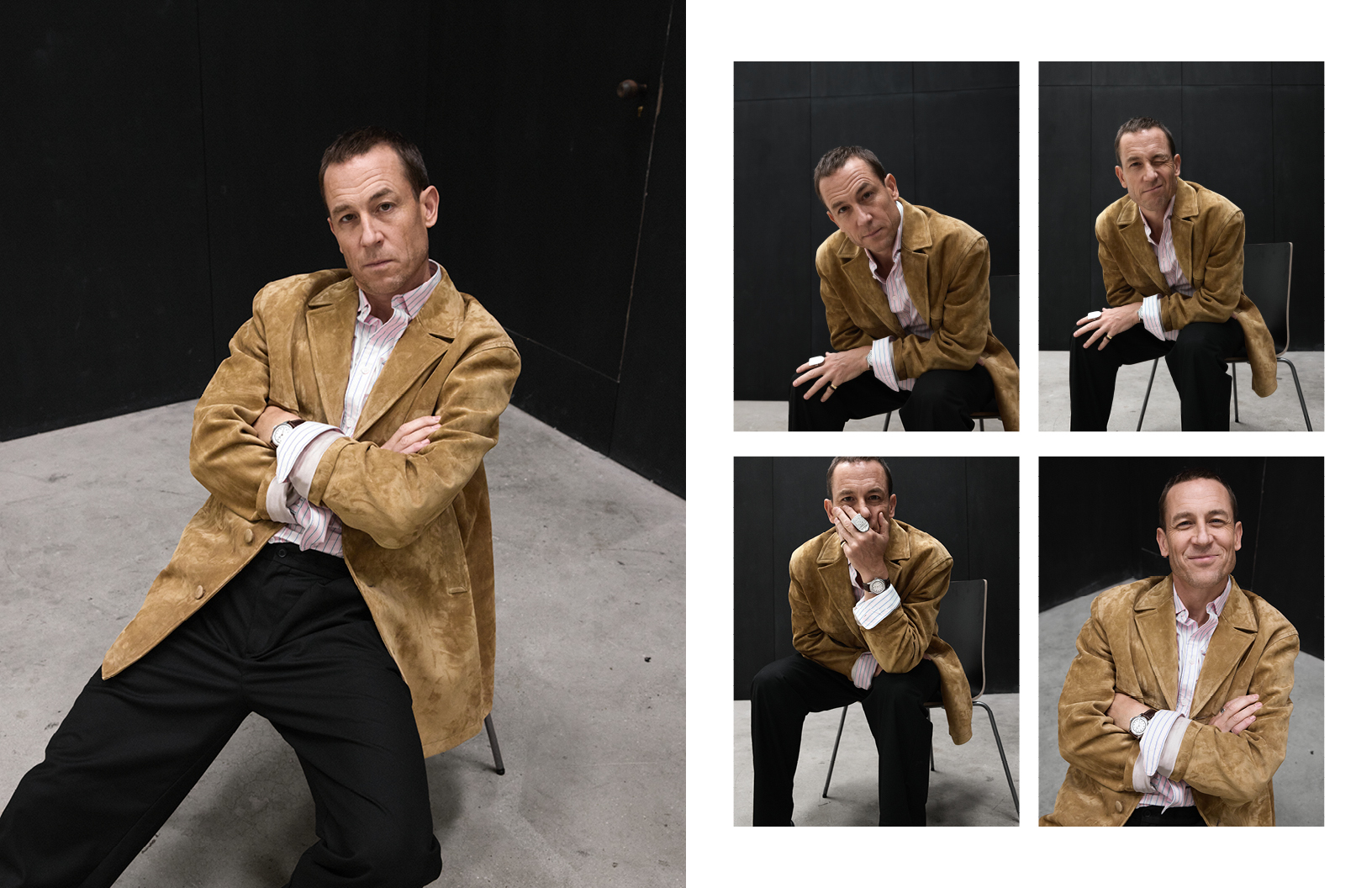
shirt + jacket. Mithridate
trousers. Reiss
opposite
shirt + jacket. Mithridate
trousers. Reiss
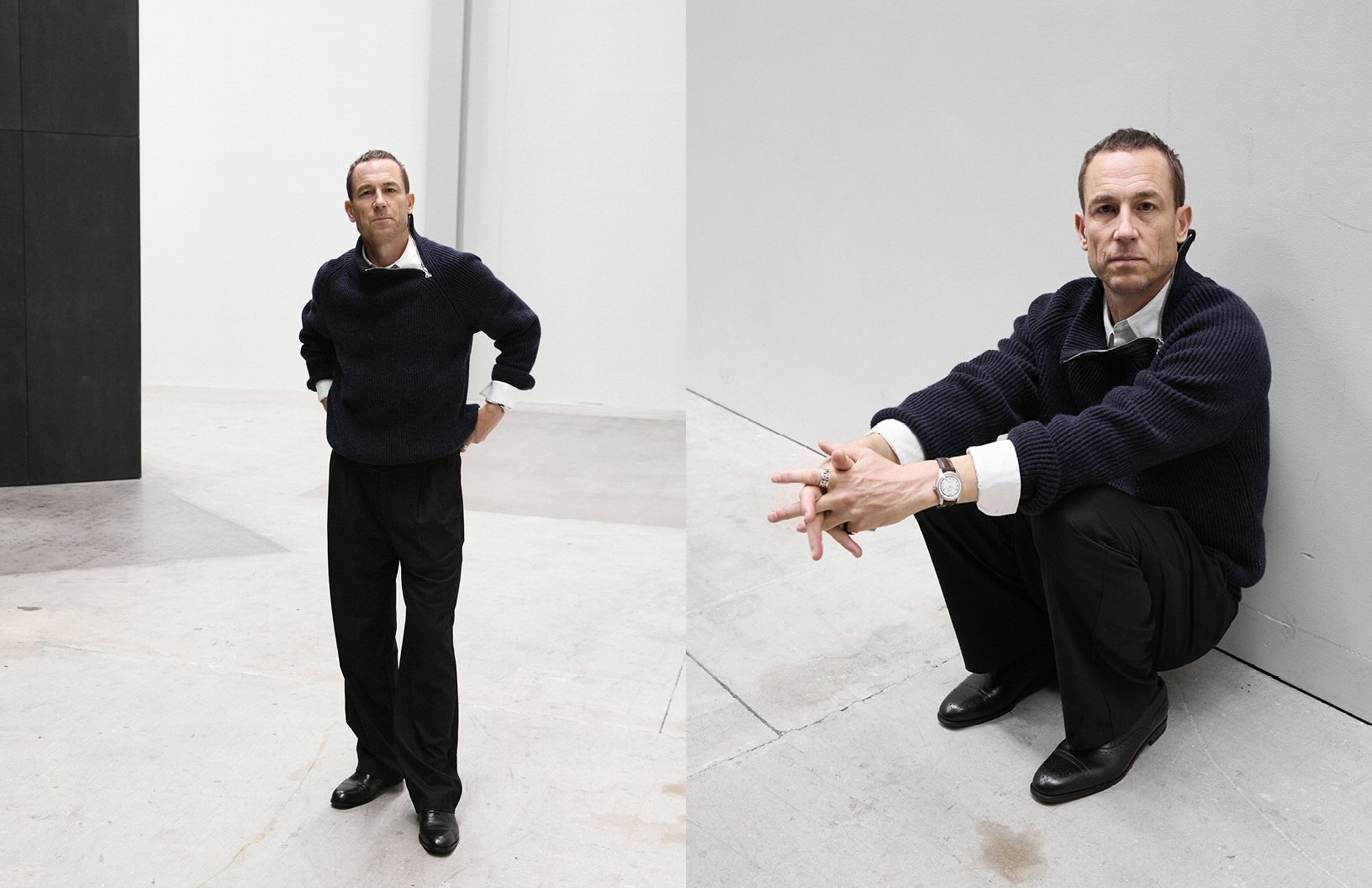
sweater. CONNOLLY
shirt. Margaret Howell
trousers. Reiss
shoes. Manolo Blahnik
opposite
sweater. CONNOLLY
shirt. Margaret Howell
trousers. Reiss
shoes. Manolo Blahnik
That’s very true. Real life is the true purveyor of art. Can we touch on ‘The Entertainment System is Down’? Because first, the name of that film is great. What attracted you to it? Also, what do you do on long-haul flights to keep yourself entertained?
My main reason for wanting to be involved in that film was a big admirer of Ruben Ostlund’s work. So, the chance to be in that room and see how he makes his films, and to contribute to that, was a really exciting proposition. It was obviously about the premise. A long-haul flight, the plane takes off, a passenger has a heart attack, and somewhere in the process of trying to revive him, the electrics of the plane blow out so that 90% of the entertainment system is down. Then it becomes a social comedy about what happens when you remove screens from society.
So, it’s Ruben looking at one of the largest technological changes in the last 15 years. It’s having one of the biggest effects on how we operate and how we think. I think if I were in that situation, I’d try and take a nap probably.
When you look back over your career, what is the definitive moment that kind of reaffirmed your love of acting?
Oh, if only it were that tidy. I don’t really see a huge amount of shape in it. I guess it’s easy to say that there have been certain roles that have been a lot more visible than others, be it Philip and ‘The Crown’, which obviously reaches a huge audience. I still think there’s work I’ve done that has been seen by hardly anyone, which I value just as much. With acting, I think you have to be the best you can be, turn up and take the work seriously and produce it properly.
Whether it’s Netflix and ‘The Crown’, reaching millions around the world, or when I did Wally Shawn’s ‘The Fever’ in a hotel room to 28 people at night. That’s as important, as rewarding, that’s just as challenging. I think they all add to the experience and the muscle. Learning is all cumulative, I think, I hope. I very much view it as a marathon, not a sprint. The thing you can’t control is how people perceive your work and what value is attached to it.
You really control impact once the art is out there, right? Do you have any stories of fans coming up to you about a project that you wouldn’t think would normally get any ripples?
I guess that’s the magic of theatre. With live experience, you never know who is in that room and who might be kind of turned on by what you do. It’s certainly how I got interested in performance and became an actor. Being energized by performances in little rooms and theatres. I’d seen a play at the Edinburgh Fringe Festival probably 20 years ago. ‘A Canadian actress’, it’s one of my formative theatre experiences. In that way, there’s a whole other history, like performer handing on to performer. They won’t be famous or well-known necessarily, but have influenced your own work significantly.
It’s a version of paying it forward.
Yes. I think that’s right. It’s an intuitive process. I think that goes for a lot of creatives, writers, and actors. We’re all taking stuff from each other, just reinventing it and making it our own.
Switching back to ‘F1,’ what would you say audiences have to look forward to about the film?
I think it’s a really fun old-school blockbuster movie; that way has quite classic story bones. I think the thing they might not have seen before is the driving. I think that feels genuinely innovative. I think it really does take an audience inside those cars, and it feels properly fast, and has a proper sort of jeopardy at the heart of it. I found it very thrilling to watch the first time I saw it. It’s got a solid old-fashioned story with some innovative filmmaking.
And my last question, what is something that you hope for yourself and the world going into next year?
On a serious note, I wore a pin on the red carpets in New York and London for a brilliant charity called Artists for Ceasefire. And I very much hope that what that charity is trying to do is help bring an immediate ceasefire and return of hostages and lifting of the blockade on aid and food and water into Gaza. That would be an amazing thing to have achieved for the beginning of next year.
Hopefully sooner rather than later.
Definitely.
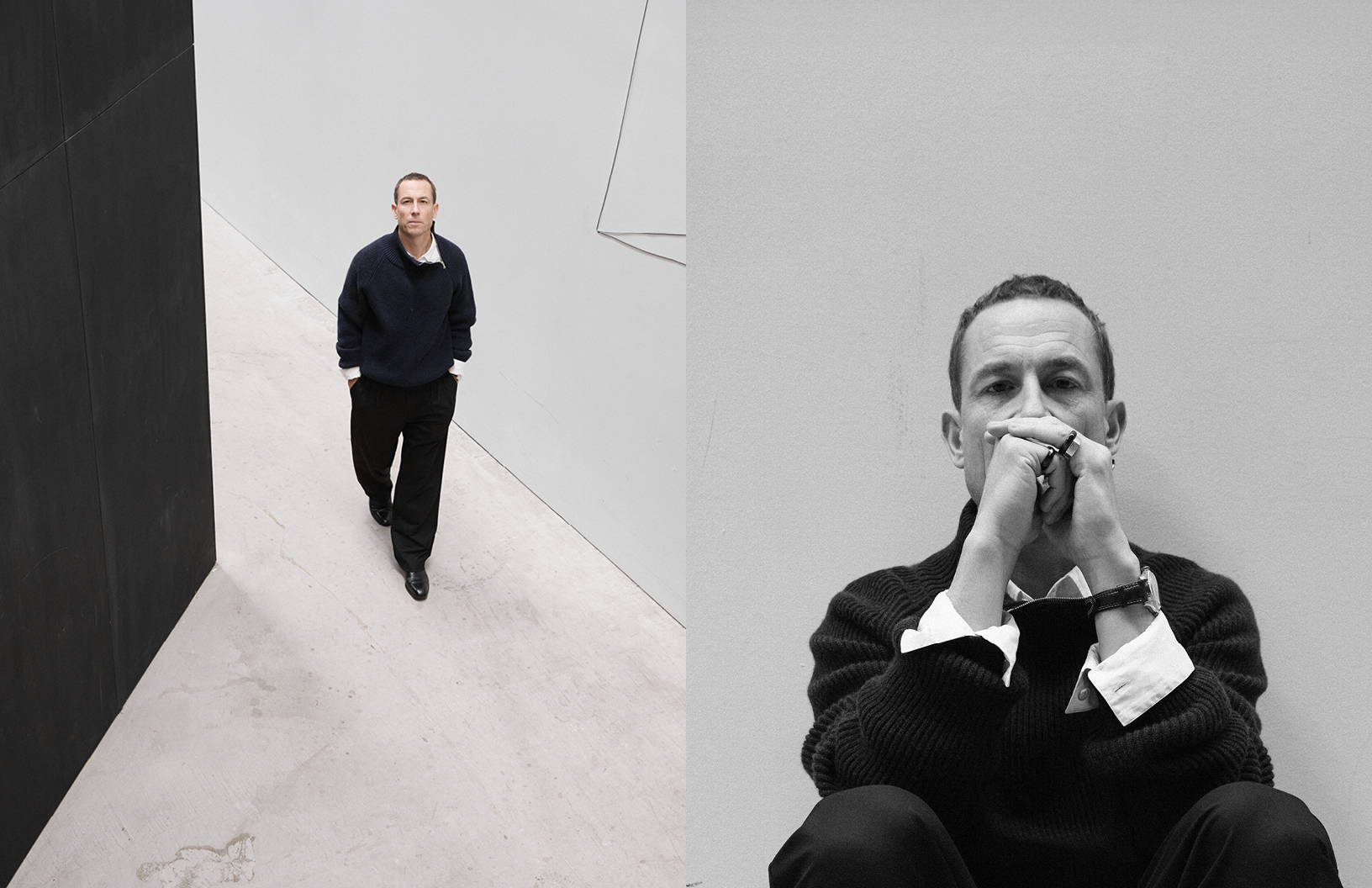
sweater. CONNOLLY
shirt. Margaret Howell
trousers. Reiss
shoes. Manolo Blahnik
opposite
sweater. CONNOLLY
shirt. Margaret Howell
trousers. Reiss
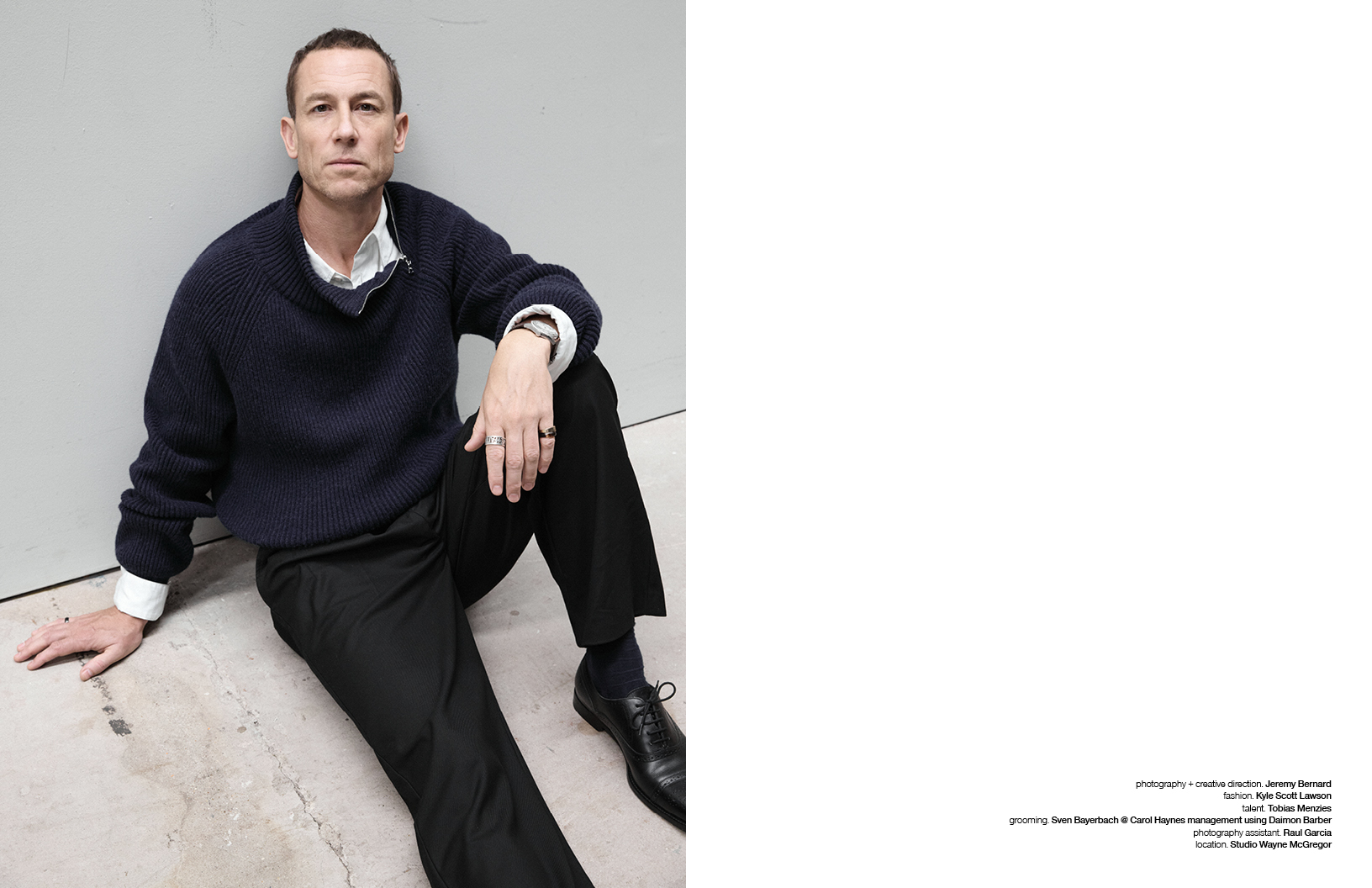
sweater. CONNOLLY
shirt. Margaret Howell
trousers. Reiss
shoes. Manolo Blahnik
‘F1: The Movie’ is in theatres now.
photography + creative direction. Jeremy Bernard
fashion. Kyle Scott Lawson
talent. Tobias Menzies
grooming. Sven Bayerbach @ Carol Haynes management using Daimon Barber
photography assistant. Raul Garcia
location. Studio Wayne McGregor
interview. Dana Reboe
in HTML format, including tags, to make it appealing and easy to read for Japanese-speaking readers aged 20 to 40 interested in fashion. Organize the content with appropriate headings and subheadings (h1, h2, h3, h4, h5, h6), translating all text, including headings, into Japanese. Retain any existing
tags from

jacket. David Koma
sweater. Connolly
trousers. Reiss
shoes. Manolo Blahnik
Tobias Menzies has had a career for the ages. Ranging from royalty to rogue and all things in between for the screen and stage, he morphs with ease from one role to another with practiced confidence. When we sit down to chat during a particularly scorching summer day, the conversation envelopes everything from the very beginning of his career, from ‘Outlander’ to ‘The Crown’, to where he is today in Apple TV’s ‘F1: The Movie’.
Working with some of the greats, Brad Pitt, Javier Bardem, and Damson Idris, Menzies finds himself in incredible company, taking everything within its stride. The first film of its kind, to be filmed alongside Formula One racers, and on a live racetrack, Menzies couldn’t pass up the opportunity to be part of something so big. Something so innovative to life.
Bringing the role of Peter Banning to life, the man with the rules and the red tape, the actor is no stranger to playing the villain or antagonist. And as our chat continues, he explains how a villain never truly sees themselves in the wrong, or as the foil. They simply believe in their convictions, which makes it all the more enthralling to portray. A villain is not a villain in their own mind, but the hero of their own story, and he relishes the chance to be able to give these characters the dimension that they deserve.
In conversation with Schön!, Menzies discusses ‘F1: The Movie’, the innovation behind the camera, what he looks for in a role, how he approaches the stage versus the screen, and much more.

jacket. Brioni
shirt. Connolly
trousers. Reiss
opposite
jacket. Brioni
shirt. Connolly
trousers. Reiss

jacket. Brioni
shirt. Connolly
trousers. Reiss
opposite
jacket. Brioni
shirt. Connolly
trousers. Reiss
You’ve been cast in period pieces, ‘Game of Thrones’, ‘Outlander’, ‘Persuasion’, ‘The Crown’, and ‘Rome’. What is it about period pieces that you love so much? Is there a particular part of history you’d like to tackle in the future?
I don’t know. I’m not quite sure what that’s about. But I guess I’m partly drawn to more classic stories that tend to have great story bones. I’m naturally drawn to that than some of the more modern material.
Beyond period pieces, is there a genre you’d like to wade into?
Nothing springs to mind. Have you got any in mind?
Maybe science fiction? I know you were in an episode of ‘Doctor Who’, so it would be cool to see you do more of that.
I’m open to that.
Moving to ‘F1’, what was it about Banning that piqued your interest when you read the script?
It was the overall package I was interested in. The world seemed inherently cinematic. I think what Joe (Korsinski) was looking to do was take an audience inside those cars, give them a real sense of the speed and the jeopardy that felt exciting. I got to work with Javier Bardem and Brad Pitt in this film. It was an amazing opportunity to see how they work up close. It felt like there was enough in the part to land something. The money is such a huge part of this sport. It’s incredibly expensive to do and to be involved in.
Banning represents some of the machinations that go on behind the scenes of what you see at the races and on TV. There’s a lot of business going on. He’s representing some of that cutthroat end of it.
He’s the red tape and the money exchanging hands that we don’t get to see, essentially.
Yes. I would say he’s an interesting part of it. I think everyone involved, Brad (Pitt) and Joe particularly, were keen to make it as authentic as possible. To make it a very accurate representation of the world overall. So, both the pit lane, but also the paddock club, and the money flows, and to see all the different strata of how this stuff works.
With all that being said, what makes Peter Banning a good villain or foil in your eyes?
I’ll be totally honest, I did not play him like a villain. I didn’t think of him as a villain, really. No one thinks of himself as a villain. I don’t think Peter Banning thinks of himself as a villain. He’s a businessman. He thinks of what would be best for the team. In a different film, he would be the hero.
Do you think there should be a part two to tell Banning’s POV?
Yeah, why not? Let’s do the spinoff [laughs].
The film is so incredibly big budget. The trailer teases extreme speed that audiences are going to be thrilled with. Were there any moments that kind of took your breath away and almost broke you out of character?
No, not while shooting. But I mean, I was on set and watching the bank of monitors at times when Damson Idris was doing what they call hot laps, where F1 gave the production use of the track in between practice sessions. The production is allowed to take out their cars and drive the real track. They would drive more than 180 miles an hour, 150 miles an hour rather, I think.
One of the things I love about the film is the camera work, specifically the technology used to place those cameras inside the car while the actors are actually driving. It gives an amazing sense of the pace they’re going at, the genuine danger of that. I don’t really feel like that’s being rendered on film as successfully as this film does. I think you get a sense of that. It was exciting to watch that happening live. The stuff we shot on Silverstone grid was a very unusual and unique sort of shooting situation. One that I’m unlikely to repeat.
Did you get the chance to go behind the wheel at any point?
No, I mean, I imagine the insurance is incredibly complex just to get Damson and Brad behind a F2 car disguised as an F1 car and to drive that fast. I don’t know how the insurance worked on that. It wasn’t an open-door policy on the car front.

jacket + sweater. Margaret Howell
trousers. REISS
shoes. Grenson
watch + jewellery. Talent’s Own
opposite
jacket + sweater. Margaret Howell
trousers. REISS
watch + jewellery. Talent’s Own

jacket. David Koma
opposite
jacket. David Koma
sweater. Connolly
trousers. Reiss
Moving away from the film for just a moment, I wanted to touch on the theatre. Can you talk a little bit about the challenges of acting between stage and screen? What creative muscles does one flex over the other?
I think it’s all the same stuff, really. It is the same activity. It’s the same muscles. It’s just, I guess, the question of the lens size, how far you’re having to sort of push it out. But I mean, my taste in theatre is less is more anyway. I think you try to make an audience come to you within reason. Similarly, with a camera, you’re wanting an audience to lean into you as well. There are a few technical differences, but in a way, they’re superficial.
I think the engine of this stuff is still the basic questions — what does the person need? What are they trying to get? What are they doing to get it? Plugging what you’re saying into those essential needs and wants. That’s always what activates the scene and activates a character and is the lifeblood of drama. That’s just as applicable on screen as it is stage.
In recent years, microphones have come into theatre a lot more. That’s changed the landscape a little bit. You go back 20 years; there was the technical challenge of projection of sounding like you’re talking to one person but being heard by 800. Technology is slightly changing the boundaries around that a little bit. Sometimes, it’s a shame, I think. Sometimes I wish it wasn’t as mic’d as it is in the theatre.
I was recently at the Globe (theatre). I didn’t see any, at least, not that I was looking for it, but I didn’t see any mics or rigs. So, I’m wondering if it’s just because of the shape of the theatre; does that play into the projection or?
I don’t know. I suspect they may not use mics. Because obviously, the invitation or the project of the Globe is seeking to keep it authentic to maybe some idea of how it was. But did it feel intimate, but still audible?
It did. I was just doing a walking tour, but they were rehearsing ‘The Crucible’. It didn’t take much for us to be able to hear, and we were way up out of the way. That was a bucket list item. Speaking of plays, is there a play you’ve always wanted to work on?
I mean, the Crucible is right up there. I’ve never worked on that. It’s a playwright (Arthur Miller) who has impacted me hugely over the years. So, yeah, maybe (John) Proctor is on the list.
That sort of leads me to my next question. When you look at future projects, what are you looking for as a creative? Is there a criteria or a box that needs to be ticked before you say ‘yes’ to something?
No, I wish I were a bit more strategic about these things. It must be a combination of scripts. Who’s making it? It’s a mixture of head and heart.
Which usually wins out?
Usually, the script is most important. Generally, over my career, I’ve chosen sort of a smaller part in a material that I believe in more than a large part of material that I don’t think is quite as good. My instinct is always to go for the material.
Seems to be working well, I’d say. Hopping off acting for just a second, on your days off, what interests you? What does a day off from filming look like, and not doing press?
There always seems to be way too many emails to answer, and chores. Life seems to be full of chores. So, there’s a lot of that. I try to get out into nature, get some exercise. I still see plenty of theatre in London. I live in London. So, seeing stuff is a good way to feed your brain. Friends, family, and ordinary life.
That’s got to feel like a little bit of whiplash, going from movie premieres at Leicester Square, and then back to real life.
But that makes the chores all the more important. You have to sort of think to be able to act; you have to know what real life is. Because there aren’t many scenes set on a premier red carpet. There are lots of scenes set in a kitchen, though [laughs].

shirt + jacket. Mithridate
trousers. Reiss
opposite
shirt + jacket. Mithridate
trousers. Reiss

sweater. CONNOLLY
shirt. Margaret Howell
trousers. Reiss
shoes. Manolo Blahnik
opposite
sweater. CONNOLLY
shirt. Margaret Howell
trousers. Reiss
shoes. Manolo Blahnik
That’s very true. Real life is the true purveyor of art. Can we touch on ‘The Entertainment System is Down’? Because first, the name of that film is great. What attracted you to it? Also, what do you do on long-haul flights to keep yourself entertained?
My main reason for wanting to be involved in that film was a big admirer of Ruben Ostlund’s work. So, the chance to be in that room and see how he makes his films, and to contribute to that, was a really exciting proposition. It was obviously about the premise. A long-haul flight, the plane takes off, a passenger has a heart attack, and somewhere in the process of trying to revive him, the electrics of the plane blow out so that 90% of the entertainment system is down. Then it becomes a social comedy about what happens when you remove screens from society.
So, it’s Ruben looking at one of the largest technological changes in the last 15 years. It’s having one of the biggest effects on how we operate and how we think. I think if I were in that situation, I’d try and take a nap probably.
When you look back over your career, what is the definitive moment that kind of reaffirmed your love of acting?
Oh, if only it were that tidy. I don’t really see a huge amount of shape in it. I guess it’s easy to say that there have been certain roles that have been a lot more visible than others, be it Philip and ‘The Crown’, which obviously reaches a huge audience. I still think there’s work I’ve done that has been seen by hardly anyone, which I value just as much. With acting, I think you have to be the best you can be, turn up and take the work seriously and produce it properly.
Whether it’s Netflix and ‘The Crown’, reaching millions around the world, or when I did Wally Shawn’s ‘The Fever’ in a hotel room to 28 people at night. That’s as important, as rewarding, that’s just as challenging. I think they all add to the experience and the muscle. Learning is all cumulative, I think, I hope. I very much view it as a marathon, not a sprint. The thing you can’t control is how people perceive your work and what value is attached to it.
You really control impact once the art is out there, right? Do you have any stories of fans coming up to you about a project that you wouldn’t think would normally get any ripples?
I guess that’s the magic of theatre. With live experience, you never know who is in that room and who might be kind of turned on by what you do. It’s certainly how I got interested in performance and became an actor. Being energized by performances in little rooms and theatres. I’d seen a play at the Edinburgh Fringe Festival probably 20 years ago. ‘A Canadian actress’, it’s one of my formative theatre experiences. In that way, there’s a whole other history, like performer handing on to performer. They won’t be famous or well-known necessarily, but have influenced your own work significantly.
It’s a version of paying it forward.
Yes. I think that’s right. It’s an intuitive process. I think that goes for a lot of creatives, writers, and actors. We’re all taking stuff from each other, just reinventing it and making it our own.
Switching back to ‘F1,’ what would you say audiences have to look forward to about the film?
I think it’s a really fun old-school blockbuster movie; that way has quite classic story bones. I think the thing they might not have seen before is the driving. I think that feels genuinely innovative. I think it really does take an audience inside those cars, and it feels properly fast, and has a proper sort of jeopardy at the heart of it. I found it very thrilling to watch the first time I saw it. It’s got a solid old-fashioned story with some innovative filmmaking.
And my last question, what is something that you hope for yourself and the world going into next year?
On a serious note, I wore a pin on the red carpets in New York and London for a brilliant charity called Artists for Ceasefire. And I very much hope that what that charity is trying to do is help bring an immediate ceasefire and return of hostages and lifting of the blockade on aid and food and water into Gaza. That would be an amazing thing to have achieved for the beginning of next year.
Hopefully sooner rather than later.
Definitely.

sweater. CONNOLLY
shirt. Margaret Howell
trousers. Reiss
shoes. Manolo Blahnik
opposite
sweater. CONNOLLY
shirt. Margaret Howell
trousers. Reiss

sweater. CONNOLLY
shirt. Margaret Howell
trousers. Reiss
shoes. Manolo Blahnik
‘F1: The Movie’ is in theatres now.
photography + creative direction. Jeremy Bernard
fashion. Kyle Scott Lawson
talent. Tobias Menzies
grooming. Sven Bayerbach @ Carol Haynes management using Daimon Barber
photography assistant. Raul Garcia
location. Studio Wayne McGregor
interview. Dana Reboe
and integrate them seamlessly into the new content without adding new tags. Ensure the new content is fashion-related, written entirely in Japanese, and approximately 1500 words. Conclude with a “結論” section and a well-formatted “よくある質問” section. Avoid including an introduction or a note explaining the process.


